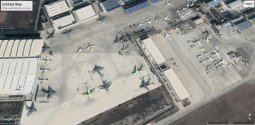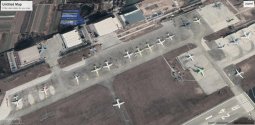You are using an out of date browser. It may not display this or other websites correctly.
You should upgrade or use an alternative browser.
You should upgrade or use an alternative browser.
Chinese Aviation Industry
- Thread starter FriedRiceNSpice
- Start date
Hendrik_2000
Lieutenant General
Another hubris and useless article ARJ21 is not the leading edge of technology but it is not outdated either It was designed for Chinese condition that require operating in high plateau of Tibet so it need to have slightly bigger engine with reduced efficiency. It is all metal construction But other than that the avionic is modern the engine is modern I don't know why they say it is outdatedChina’s Potemkin Aviation Can’t Survive Without Washington’s Help – Jaweb
After many decades and tens of billions of dollars, China’s airliners are case studies in failure. A few dozen dysfunctional turboprops and 43 ARJ21 regional jets are the only products in the air, and they represent less than 0.5 percent of China’s air service capacity. China’s air fleet comprises thousands of much larger Airbus and Boeing aircraft, which are from Europe and the United States. The turboprops have a dismal safety record, and the ARJ21 is overweight and obsolete with last-generation technologies. Meanwhile, the MA700 and the C919 single-aisle jetliners have been in development for years, with numerous delays, and merely aim to replicate Western products that have been flying for decades. And the proposed CR929 twin-aisle transport airliner is aspirational at best.
Even China’s minimal aviation achievements thus far would be useless without Western engines, avionics, systems, and everything else needed to get chunks of metal off the ground. The point of China’s joint ventures with Western companies is to make this possible domestically, but it still has a long way to go, and the MEU list might stop it altogether. Without Western equipment, China’s jetliners would be hollow shells.
The list also shows that developing these necessary systems with Chinese rather than U.S. technology would be highly impractical. Currently, China makes its own airframes, the structures of aircraft. Yet while airframes are complex objects, the technologies that make them fly are even more complex. They have more in common with semiconductors (and China’s semiconductor production has been difficult, to say the least). A crash program to develop engines, avionics, and other necessary technologies at home would take well over a decade and tens of billions of dollars, even if the country looks to Russia for assistance. It would also guarantee inferior, less reliable, and less efficient products fit only for a domestic market. No country has achieved this level of self-sufficiency with the possible exception of the Soviet Union in the 1970s and 1980s.
Even if it use western avionic but it is built in China by joint venture partner so are most of the other components including landing gear and AC system. It is built domestically right now since the program already run for at least a decade. It produced at 30 plane per year So it is success their contemporary the Mitsubishi MRJ is cancelled Bombardier and Embraer went out of business so what is this guy talking other than bad mouthing nascent Chinese aviation.
Worse come worse Chinese industry can supply most of the avionic if necessary the fact that they use western avionic is due to marketing and certification acceptance making it easier by using standard avionic
Hendrik_2000
Lieutenant General
ARJ 21 is not the end goal by itself but a stepping stone and learning process to a bigger and better thing which is CJ 919. No civilian airliner project is on schedule they normally suffer hiccup and teething problem but when it come to China the western analyst, media, blogger just criticize it with vengeance as to convince themselves that China will never catch up. But reality is something else slow as it goes China make progress.
China Eastern Airlines has signed a sales contract with COMAC for the first five C919 planes and plans to deliver the first one this year.
China Eastern Airlines has signed a sales contract with COMAC for the first five C919 planes and plans to deliver the first one this year.
@
@Hendrik_2000 a good replacement for China Eastern B737 MAX which is still grounded in China, a good play comrade.ARJ 21 is not the end goal by itself but a stepping stone and learning process to a bigger and better thing which is CJ 919. No civilian airliner project is on schedule they normally suffer hiccup and teething problem but when it come to China the western analyst, media, blogger just criticize it with vengeance as to convince themselves that China will never catch up. But reality is something else slow as it goes China make progress.
China Eastern Airlines has signed a sales contract with COMAC for the first five C919 planes and plans to deliver the first one this year.
Hendrik_2000
Lieutenant General
Well well seem like they try to speed up development for CJ1000
Fri, March 5, 2021, 2:02 AM
BEIJING (Reuters) - China will push forward with the development of CJ1000, a turbofan jet engine designed to power the homemade C919 narrowbody aircraft, the government said on Friday in its development plan for the 2021-2025 period.
It also aims to achieve breakthrough in engine technology for widebody jets, the government said.
Chinese-made civil aircraft, including the C919, currently use foreign engines but the country has been trying to develop a home-grown alternative as it seeks to cut its dependence on foreign sources of sophisticated technology.
In 2018, the United States charged Chinese intelligence officers for a data hack to steal information on a turbo fan engine used in commercial jetliners. China denied the charges.
China's C919 plane is on track to get its airworthiness certification by the end of 2021 and deliver the first aircraft to the launch customer, Wu Guanghui, chief designer of the C919 programme, said on Friday.
China Eastern Airlines, which is the launch customer, signed a firm order on Monday to buy 5 C919 jets.
The government will also push for "exemplary operations" of C919 over the next five years, it said.
Russia, which has teamed up with China to develop the widebody jet CR929, in December flew a new passenger airliner with domestically built engines for the first time since the Soviet era.
(Reporting by Stella Qiu in Beijing and Jamie Freed in Sydney; Editing by Himani Sarkar)
China outlines push to develop domestic engine for C919 jet in five-year plan
Fri, March 5, 2021, 2:02 AM
BEIJING (Reuters) - China will push forward with the development of CJ1000, a turbofan jet engine designed to power the homemade C919 narrowbody aircraft, the government said on Friday in its development plan for the 2021-2025 period.
It also aims to achieve breakthrough in engine technology for widebody jets, the government said.
Chinese-made civil aircraft, including the C919, currently use foreign engines but the country has been trying to develop a home-grown alternative as it seeks to cut its dependence on foreign sources of sophisticated technology.
In 2018, the United States charged Chinese intelligence officers for a data hack to steal information on a turbo fan engine used in commercial jetliners. China denied the charges.
China's C919 plane is on track to get its airworthiness certification by the end of 2021 and deliver the first aircraft to the launch customer, Wu Guanghui, chief designer of the C919 programme, said on Friday.
China Eastern Airlines, which is the launch customer, signed a firm order on Monday to buy 5 C919 jets.
The government will also push for "exemplary operations" of C919 over the next five years, it said.
Russia, which has teamed up with China to develop the widebody jet CR929, in December flew a new passenger airliner with domestically built engines for the first time since the Soviet era.
(Reporting by Stella Qiu in Beijing and Jamie Freed in Sydney; Editing by Himani Sarkar)
So they are compromising on the principle of free and fair competition to protect their hegemony.U.S., EU agree tariff freeze in aircraft dispute, eye China
Philip Blenkinsop and David Lawder
Sat, March 6, 2021, 1:22 AM
they put aside their decades long feud, now they've got a common adversary.
Their definition of "rule of law" applies only to protect their own hegemonic goals.


